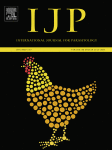Ver ítem
- xmlui.general.dspace_homeCentros e Institutos de InvestigaciónCICVyA. Centro de Investigación en Ciencias Veterinarias y AgronómicasInstituto de BiotecnologíaArtículos científicosxmlui.ArtifactBrowser.ItemViewer.trail
- Inicio
- Centros e Institutos de Investigación
- CICVyA. Centro de Investigación en Ciencias Veterinarias y Agronómicas
- Instituto de Biotecnología
- Artículos científicos
- Ver ítem
The key to egress? Babesia bovis perforin-like protein 1 (PLP1) with hemolytic capacity is required for blood stage replication and is involved in the exit of the parasite from the host cell
Resumen
Bovine babesiosis is a tick-borne disease caused by apicomplexan parasites of the Babesia genus that represents a major constraint to livestock production worldwide. Currently available vaccines are based on live parasites which have archetypal limitations. Our goal is to identify candidate antigens so that new and effective vaccines against Babesia may be developed. The perforin-like protein (PLP) family has been identified as a key player in cell
[ver mas...]
Bovine babesiosis is a tick-borne disease caused by apicomplexan parasites of the Babesia genus that represents a major constraint to livestock production worldwide. Currently available vaccines are based on live parasites which have archetypal limitations. Our goal is to identify candidate antigens so that new and effective vaccines against Babesia may be developed. The perforin-like protein (PLP) family has been identified as a key player in cell traversal and egress in related apicomplexans and it was also identified in Babesia, but its function in this parasite remains unknown. The aim of this work was to define the PLP family in Babesia and functionally characterize PLP1, a representative member of the family in Babesia bovis. Bioinformatic analyses demonstrate a variable number of plp genes (four to eight) in the genomes of six different Babesia spp. and conservation of the family members at the secondary and tertiary structure levels. We demonstrate here that Babesia PLPs contain the critical domains present in other apicomplexan PLPs to display the lytic capacity. We then focused on the functional characterization of PLP1 of B. bovis, both in vitro and in vivo. PLP1 is expressed and exposed to the host immune system during infection and has high hemolytic capacity under a wide range of conditions in vitro. A B. bovis plp1 knockout line displayed a decreased growth rate in vitro compared with the wild type strain and a peculiar phenotype consisting of multiple parasites within a single red blood cell, although at low frequency. This phenotype suggests that the lack of PLP1 has a negative impact on the mechanism of egression of the parasite and, therefore, on its capacity to proliferate. It is possible that PLP1 is associated with other proteins in the processes of invasion and egress, which were found to have redundant mechanisms in related apicomplexans. Future work will be focused on unravelling the network of proteins involved in these essential parasite functions.
[Cerrar]

Autor
Paoletta, Martina;
Laughery, Jacob Michael;
Lopez Arias, Ludmila Sol;
Jaramillo Ortiz, Jose;
Montenegro, Valeria Noely;
Petrigh, Romina;
Ueti, Massaro W.;
Suarez, Carlos Esteban;
Farber, Marisa Diana;
Wilkowsky, Silvina Elizabeth;
Fuente
International Journal for Parasitology 51 (8) : 643-658 (July 2021)
Fecha
2021-07
Editorial
Elsevier
ISSN
0020-7519
Formato
pdf
Tipo de documento
artículo
Palabras Claves
Derechos de acceso
Restringido
 Excepto donde se diga explicitamente, este item se publica bajo la siguiente descripción: Creative Commons Attribution-NonCommercial-ShareAlike 2.5 Unported (CC BY-NC-SA 2.5)
Excepto donde se diga explicitamente, este item se publica bajo la siguiente descripción: Creative Commons Attribution-NonCommercial-ShareAlike 2.5 Unported (CC BY-NC-SA 2.5)

